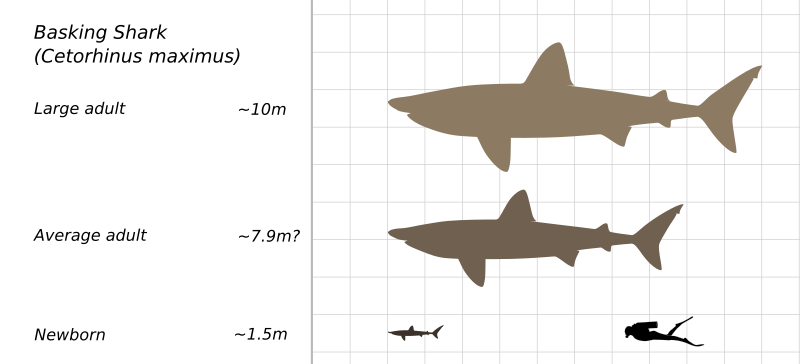Image: Basking-Shark-Scale-Chart-SVG-Steveoc86-001

Description: A diagram showing a newborn, an average-sized adult, and large adult basking shark (Cetorhinus maximus). • The maturity and growth of the basking shark are poorly understood.[1][2]
• Newborn basking sharks are around 1.5m - 1.7m in length (1.5m shown here).[1][3]
• The size at maturity for each sex is unclear and varies from source to source. For male basking sharks, stated maturity sizes range from between 4.6 - 7.5m in length.[4][2][3][5] The size at sexual maturity for female basking sharks in published sources is usually larger than males ranging from 7.7 - 9.8m in length.[1][2][3][4] Matthews (1950) and Natanson et al. (2008) considered basking sharks over ~7m (~23ft) to be mature[6][7]. Wood (1982) suggested the average adult length of 7.9m, shown here.[8] There is also evidence of variation in mean size between different oceans and the northern and southern hemispheres.[9]
• Many large basking sharks have been reported in the region of 9-11m in length.[2][8][4][10][11][12] Evidence suggests that females grow slightly larger than males.[3]
• The largest size the basking shark can reach is uncertain. There are reports of basking sharks in the region of 12 - 15m in length, but these lack good evidence.[13][8][14][12][3] An individual recorded as 40ft 3in (12.27m) caught in a herring net in Musquash Harbor 1851 is often cited as the largest.[8][9] Perley (1852), the probable source of this claim, simply describes it as 40ft.[15] A study looking at the growth and longevity of the basking shark concluded that anything larger than ~10m was unlikely.[16]
• There is the possibility of error when measuring a shark's total length, which can vary depending on the method used to calculate it. Some reports calculate the total length by adding on the caudal fin to the pre-caudal length, or by stretching the caudal fin to the maximum possible (referred to as stretched total length). These methods ignore the angle at which the tail naturally sits, which artificially increases the total length of the shark being measured. The other method is to try and pose the shark's caudal fin as it would be in life. However, this is difficult in large sharks; any inaccuracy in the angle of the caudal fin can affect the reported total length measurement.[17] Another issue is it's not always clear whether the reported total length was measured over the curves of the body or straight line distance, which can also artificially produce a longer length.[8][11] This possibility of error in measuring or reporting of total length could affect the sizes shown here.
References
↑ a b c Sims, D. W. (1997). "Basking shark occurrence off south-west England in relation to zooplankton abundance". Journal of Fish Biology 51 (2): 436–440. DOI:10.1111/j.1095-8649.1997.tb01677.x. ISSN 0022-1112.
↑ a b c d (2008) Sieving a living: A review of the biology, ecology and conservation status of the plankton-feeding basking shark Cetorhinus maximus, 54, pp. 171–220 DOI: 10.1016/S0065-2881(08)00003-5. ISBN: 9780123743510.
↑ a b c d e Compagno, Leonard J. V. (2002) Sharks of the world : an annotated and illustrated catalogue of shark species known to date, Rome: United Nations Development Programme ISBN: 92-5-101384-5. OCLC: 12214754.
↑ a b c Hernández, Sebastián (2010). "Review of the occurrence and distribution of the basking shark ( Cetorhinus maximus) in Chilean waters". Marine Biodiversity Records 3: e67. DOI:10.1017/S1755267210000540. ISSN 1755-2672.
↑ Francis, M. (2002-04-01). "Distribution, seasonal abundance and bycatch of basking sharks (Cetorhinus maximus) in New Zealand, with observations on their winter habitat". Marine Biology 140 (4): 831–842. DOI:10.1007/s00227-001-0744-y. ISSN 1432-1793.
↑ Matthews, Leonard Harrison (1950-04-05). "Reproduction in the basking shark, Cetorhinus maximus (gunner)". Philosophical Transactions of the Royal Society of London. Series B, Biological Sciences 234 (612): 247–316. DOI:10.1098/rstb.1950.0003.
↑ Natanson, Lj (2008-06-09). "Ontogenetic vertebral growth patterns in the basking shark Cetorhinus maximus". Marine Ecology Progress Series 361: 267–278. DOI:10.3354/meps07399. ISSN 0171-8630.
↑ a b c d e Wood, Gerald L. (1982) The Guinness book of animal facts and feats (3rd ed ed.), Enfield, Middlesex: Guinness Superlatives ISBN: 0-85112-235-3. OCLC: 9852754.
↑ a b McClain, Craig R. (2015-01-13). "Sizing ocean giants: patterns of intraspecific size variation in marine megafauna". PeerJ 3: e715. DOI:10.7717/peerj.715. ISSN 2167-8359.
↑ Schwartz, F. J. (2010). "Basking and whale sharks of North Carolina". Journal of the North Carolina Academy of Science 126: 84-87.
↑ a b Matthews, L. Harrison (1950). "Notes on the anatomy and biology of the Basking Shark (Cetorhinus maximus (Gunner)).". Proceedings of the Zoological Society of London 120 (3): 535–576. DOI:10.1111/j.1096-3642.1950.tb00663.x. ISSN 1469-7998.
↑ a b Castro, José I. (2011) The sharks of North America, Oxford University Press ISBN: 978-0-19-539294-4. OCLC: 777927872.
↑ Matthews, L. Harrison (1950). "Notes on the anatomy and biology of the Basking Shark (Cetorhinus maximus (Gunner)).". Proceedings of the Zoological Society of London 120 (3): 535–576. DOI:10.1111/j.1096-3642.1950.tb00663.x. ISSN 1469-7998.
↑ Carwardine, Mark (2008) Animal Records, Category:New York: Sterling ISBN: 9781402756238.
↑ Perley, M. H. (1852) Three descriptive catalogues of the fishes of New Brunswick and Nova Scotia, pp. 222−223
↑ Pauly, D.; Fowler, Sarah L., Reed, Tim M., Dipper, Frances, 1951-, IUCN--The World Conservation Union. Species Survival Commission. (2002) Growth and Mortality of the Basking Shark Cetorhinus maximus and their Implications for Management of Whale Sharks Rhincodon typus, Elasmobranch biodiversity, conservation, and management : proceedings of the international seminar and workshop, Sabah, Malaysia, July 1997, Gland, Switzerland: IUCN ISBN: 2-8317-0650-5. OCLC: 50526779.
↑ Rowat, D. (2012). "A review of the biology, fisheries and conservation of the whale shark Rhincodon typus". Journal of Fish Biology 80 (5): 1019–1056. DOI:10.1111/j.1095-8649.2012.03252.x. ISSN 1095-8649.
Author: Steveoc 86
Usage Terms: Creative Commons Attribution-Share Alike 3.0
License: CC-BY-SA-3.0
License Link: http://creativecommons.org/licenses/by-sa/3.0/
Attribution Required?: Yes
Image usage
The following page links to this image:

